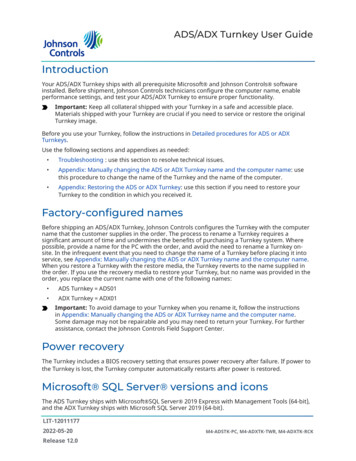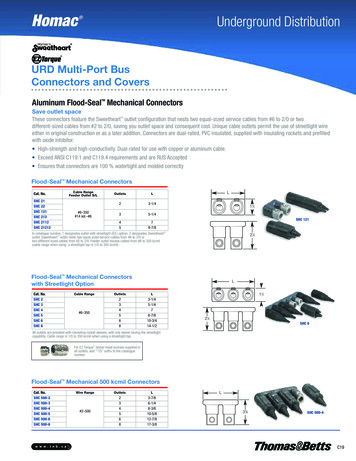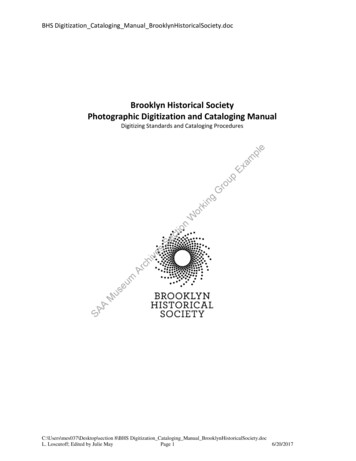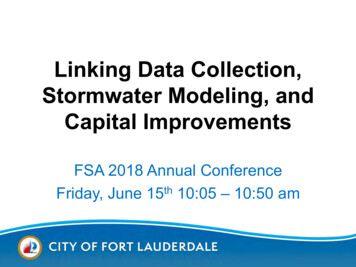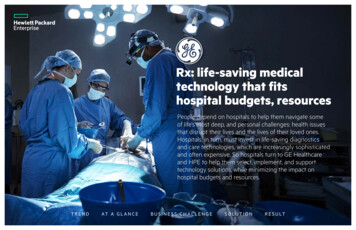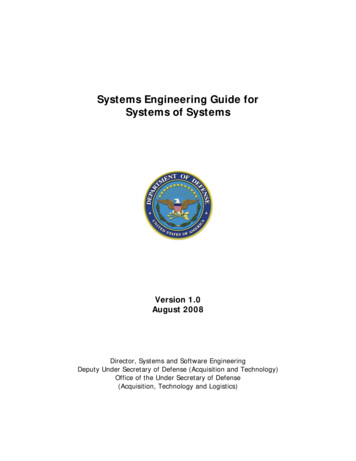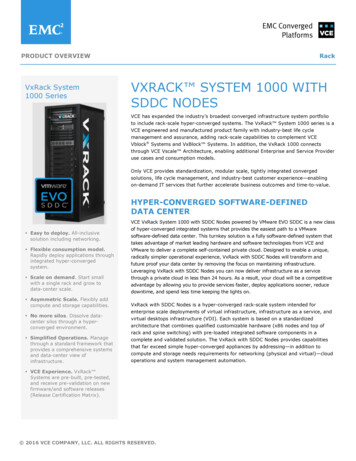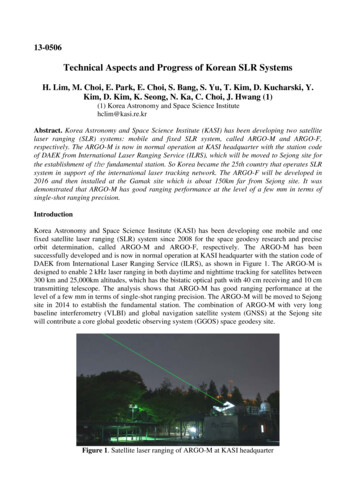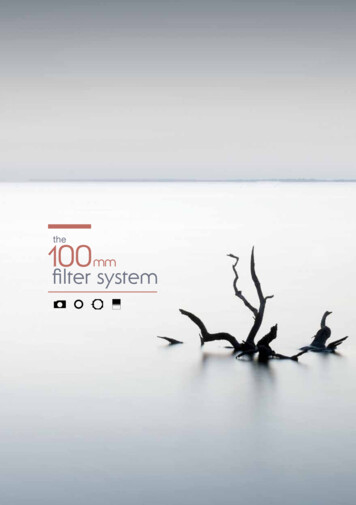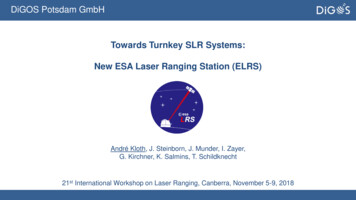
Transcription
DiGOS Potsdam GmbHTowards Turnkey SLR Systems:New ESA Laser Ranging Station (ELRS)André Kloth, J. Steinborn, J. Munder, I. Zayer,G. Kirchner, K. Salmins, T. Schildknecht21st International Workshop on Laser Ranging, Canberra, November 5-9, 2018
Introduction A bit of history .– Initial ideas iterations started at the beginning of 2016– Modern SLR system, but low budget, COTS driven implementation satisfying the high performance requirements for thevariety of planned usage– ELRS project started at the beginning of 2018– Contract duration of 24 months including commissioning (Tenerife reference site) ESA/ESOC objectives for own SLR station (ELRS)– State-of-the-art– Turnkey solution– Flexible Multi-mission, multi-customer LRS for various applications (Space Situational Awareness, Space Traffic Mgmt., collision avoidance,re-entry prediction, contingencies, ILRS, ERS, ENVISAT, CryoSat, spacecraft fine positioning, electric propulsion monitoring fromGTO to GEO, GNSS orbit calibration, precise orbit monitoring for science gravimetry, emergency spacecraft support, etc.) Optical Ground Station for Space-to-Ground Laser Comm links from LEO / Lunar Orbits Test bed for critical optical sensor technology developments & support industry in maturing commercial products Gain operational expertise, advance station autonomy, etc.DiGOS Turnkey SLR System – 21st International Workshop on Laser Ranging, Canberra, 5-9 November 20182
ELRS Site Planned installation site– Observatorio del Teide on Tenerife/Spain– 2300m above MSL with very good seeing / atmospheric conditions– Limitation: Use of IR lasers at night onlyBy Google MapsBy Instituto de Astrofísica de Canarias - IAC Backup site– La Silla/ChileDiGOS Turnkey SLR System – 21st International Workshop on Laser Ranging, Canberra, 5-9 November 20183
Atmospheric Conditions: Potsdam vs. Observatorio del TeideDiGOS Turnkey SLR System – 21st International Workshop on Laser Ranging, Canberra, 5-9 November 20184
ELRS Team Consortium of European companies and institutes (D, A, CH, LV) Prime: DiGOS Potsdam GmbH (D) Team members:– Space Research Institute (IWF, A), Austrian Academy of Sciences [Graz SLR Station]– Astronomical Institute of University of Bern (AIUB, CH) [Zimmerwald SLR Station]– Institute of Astronomy, University of Latvia (LV) [Riga SLR Station]– ASA Astrosysteme GmbH (A)– Baader Planetarium GmbH (D)– Eventech Ltd. (LV)DiGOS Turnkey SLR System – 21st International Workshop on Laser Ranging, Canberra, 5-9 November 20185
ELRS Requirements Technical Key Requirements– Laser Ranging to cooperative targets as starting point– Telescope: 80cm, 4 foci, 85% reflectivity, blind pointing accuracy 5arcsec, jitter 1arcsec– Laser & detector: 532 & 1064nm operation– Debris camera: Demonstration of passive-optical space debris observation– Laser ranging tracking performance: Galileo NP accuracy 10mm over 5min (goal: 5mm down to 15 elevation) General tracking down to 15 elevation– Remote operation including station protection & laser safety subsystems– Site infrastructure: Building and interfaces are customer provided Flexible & support easy future upgrade capabilities– Space-to-ground laser communication– Laser ranging to non-cooperative (e.g. space debris) targets– General test-bed for other optical technologies– Full automated & autonomous operationDiGOS Turnkey SLR System – 21st International Workshop on Laser Ranging, Canberra, 5-9 November 20186
ELRS Design Overview / Key Elements Comprises mostly COTS based elements Astronomical telescope 4 foci (2 Nasmyth, 2 folded Cassegrain)– Off the shelf astronomical telescope with slight adaptations– Ritchey-Chrétien, 80cm main mirror, AltAz mount– Special feature: No Coudé path Picosecond laser Detector package attached to Nasmyth focus/port Debris camera for passive-optical space debris observation Eventech Event Timer & DiGOS/GFZ Range Gate Generator Slit-type dome for easy, weather independent access during HW upgrades, experiments, etc. SCOPE control, monitoring & operation systemDiGOS Turnkey SLR System – 21st International Workshop on Laser Ranging, Canberra, 5-9 November 20187
ELRS Laser Package 400Hz Picosecond laser 532 & 1064nm wavelengths (switchable) Two transmit telescopes/optics in one package Piggyback installation onto telescope Separate laser head & pumping unit Based on proven IWF/SP-DART & GFZ expertiseDiGOS Turnkey SLR System – 21st International Workshop on Laser Ranging, Canberra, 5-9 November 20188
ELRS Detector Package 532 & 1064nm detectors Light curves detector (prepared) Camera for star calibration / mount model Based on proven IWF/SP-DARTDiGOS Turnkey SLR System – 21st International Workshop on Laser Ranging, Canberra, 5-9 November 20189
ELRS Station LayoutDiGOS Turnkey SLR System – 21st International Workshop on Laser Ranging, Canberra, 5-9 November 201810
ELRS Expected Performance (Returns)DiGOS Turnkey SLR System – 21st International Workshop on Laser Ranging, Canberra, 5-9 November 201811
ELRS Status Schedule– Station Requirements Review (SRR) & Design Review (DR) successfully completed– Manufacturing ongoing, first components deliveries expected end 2018/spring 2019– First observations summer 2019– FAT with pre-integrated system (except for dome) at telescope producer site autumn 2019– Delivery/final Installation & commissioning up to end of 2019 Operational before next workshop DiGOS Turnkey SLR System – 21st International Workshop on Laser Ranging, Canberra, 5-9 November 201812
DiGOS Turnkey SLR System -21st International Workshop on Laser Ranging, Canberra, 5-9 November 2018 6 ELRS Requirements Technical Key Requirements -Laser Ranging to cooperative targets as starting point -Telescope: 80cm, 4 foci, 85% reflectivity, blind pointing accuracy 5arcsec, jitter 1arcsec
